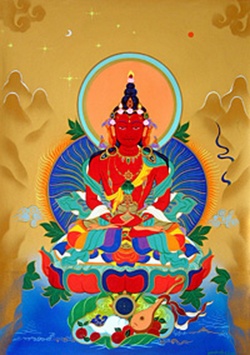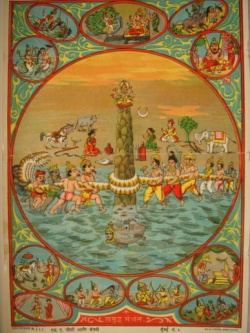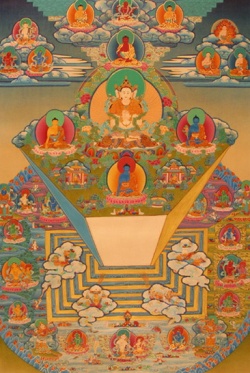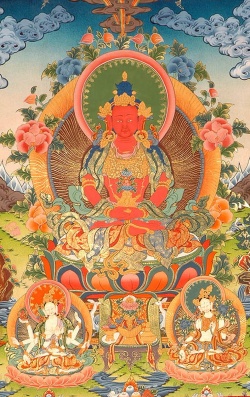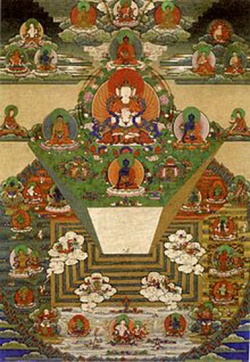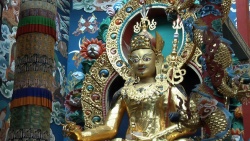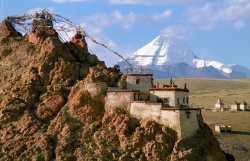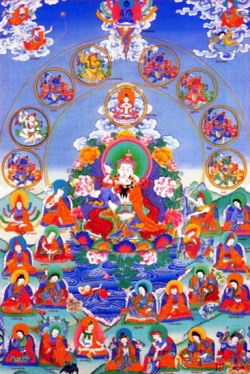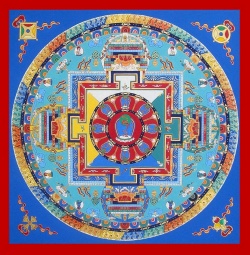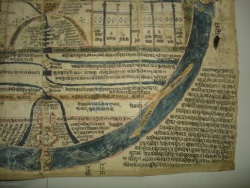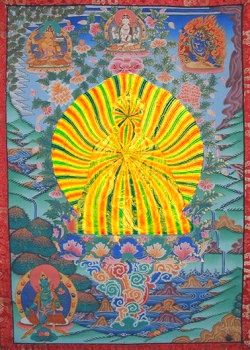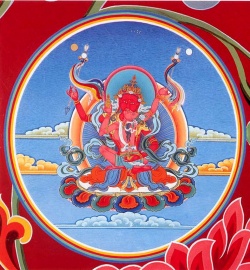Dazzling white and fair to see are Himalayas' peaks
The Himalayas are the highest mountains in the world. They form a giant arch 2500 kilometres long, between 200 and 300 kilometres wide and define the northern boundary of the Indian sub-continent. The Jatakas describe the Himalayas as “a vast region, five hundred yojanas high and three thousand in breadth.” (Ja.V,415). To the ancient Indians they were “the thousand-peaked mountains” or “the measuring rod of the world.” The Hindu scriptures know them as Devabhumi, “The Abode of the Gods” whilst the Buddha called them Pabbataraja, “The [[Lord of Mountains[[” (S.II,137). The exact meaning of the name Himalaya is uncertain. It may have been formed from the words hima and māla meaning “garland of snow” or from hima and ālaya meaning “abode of snow.” Both meanings are appropriate for these majestic mountains. Viewed from a distance in summer or winter, they give the appearance of a string of pure white blossoms and no matter how pleasantly warm it may be down in the valleys during the summer, there is always snow on the horizon. Although more often associated with Hinduism, the Himalayas are also often mentioned in the Buddhist scriptures and were familiar to the Buddha himself. He would have seen these great ice and rock ramparts long before he renounced the world to begin his quest for truth. The spectacular 8167 meter high sentinel of Dhaulagiri can be clearly seen from his hometown of Kapilavatthu. Perhaps he had this particular mountain in mind when he compared the virtuous person to the dazzling sun-lit snow peaks.
Shortly after his enlightenment, the Buddha is said to have used his super-normal powers to visit Lake Anotatta, now identified with Lake Manasarovar near the foot of Mount Kailash (Vin.I,27). Later in life, he occasionally “sojourned in a forest hut in the Himalayan region,” probably the thickly wooded hills of the lower Kumaon or the Mahabarata Lekha of Nepal (S.I,116). It is hard to know how far into the mountains the Buddha may have gone but he once mentioned “the rugged uneven places in the Himalayas where hunters and their prey could go and beyond it, the regions where neither man nor beast can penetrate.” (S.V,148). Some of his direct disciples, following the hoary tradition of Indian ascetics, would have gone up into the mountains to find peace and solitude.
In the Jatakas, the Buddha is attributed with asking his monks: “[[Do you wish to go wandering in the[Himalayas]]?” (Gacchissatha pana Himavantā cārikaṁ, Ja.V,415). The Himalayas feature prominently in early Buddhist geography. India was known to the ancient Buddhists as Jambudipa and was one of the four great continents that made up the world. The northern border of this land was defined by the Usiraddhaja Mountains (Vin.IV,197) and beyond that were the Himalayas, the region sometimes called Himava, Himacala or Himavata. The Jatakas name numerous caves, plateaus, valleys, hermitages and rivers in the Himalayas but almost none of these can be identified today. The most famous cave was somewhere near the foot of Mount Nanda and was thus known as Nandamula Cave.
Pacceka Buddhas are mentioned as living in this cave and flying from there to Varanasi or elsewhere in India, and back again (Ja.III,157,190; 230; 259). In one place it describes one of these mysterious saintly men like this: “He wore rag robes red as lac, dark as a rain cloud, his belt was yellow like a flash of lightning and the clay bowl hanging over his shoulder was as brown as a bumble bee. He rose into the air and after having given a talk on Dhamma he flew to the Nandamula Cave in the north of the Himalayas.” (J.IV,114). Seven of the biggest lakes mentioned in the Jataka are Kannamundaka, Rathakara, Sihapapata, Chaddanta, Tiyaggala, Anotatta and Kunala; and some of the more prominent peaks were Manipabbata, Hingulapabbata, Ajanapabbata, Sanupabbata and Phalikapabbata (Ja.V,415). Two peaks that can be identified are Kelasa, now known as Kailash (Ja.VI,490) and Nanda which is of course the 7817 meter high Nanda Devi, the second highest peak in India (Ja.IV,216; 230; 233).
Amongst the first range of hills or perhaps beyond them (ancient geography is sometimes unclear or contradictory) was Uttarakuru, Northern Kuru, from which the modern district of Kulu derives its name. Uttarakuru was seen as a kind of garden of earthly delights, a paradise of eternal sunshine and free love where healing herbs and fragrant flowers grew in abundance and all kinds of fantastic creatures lived without care or toil. According to the Atanatiya Sutta, the rice that grew in Uttarakuru was self-sown, fragrant and without husks, the people travelled on the backs of beautiful maidens or comely youths, the trees always hung heavy with fruit and “peacocks screech, herons call and cuckoos gently warble.” (D.III,199). Somewhere in Uttarakuru, Kuvera, the king of the north and the god of good fortune, had his jewel-encrusted palace (D.III,201). If the modern visitor travels through Garhwal or Kumaon, at least during the spring time, he or she can easily understand how such legends developed.
These regions offer some of the most enchantingly beautiful prospects to be seen anywhere on earth. Beyond the Himalayas was a huge mountain called Kelasa, Sumeru, Seneru, Neru or more commonly Meru. This mountain has long been thought of by Indian Buddhists, Hindus and Jains as being the axis of the world, the point at which the four great continents met (S.II,139; Ja.I,25; III,247). Meru of course, corresponds with Mount Kailash near the southern edge of the Tibetan Plateau. Although not the loftiest mountain in the region, all the peaks around Kailash are much lower than it, giving it the impression of immense height and grandeur. Kailash's nearly symmetrical pyramid-shaped snowy summit, marked with several black horizontal gashes, give it a distinct hub-like appearance. Although fanciful in parts and completely wrong in others, the ancient Buddhist conception of India and the region to its north was relatively correct in its general outline.
The Himalayas are used as the setting for numerous Jataka stories. In many of his previous lives the Buddha renounced the world and went to live as an ascetic in the mountains or retired there towards the end of his life (e.g. Ja.I,140; 362; 371; 406; 440). He and other ascetics lived off wild fruit and grains and often made friends with the forest creatures. As the winter approached they would come down to the plains to escape the cold, collect salt, vinegar and other supplies and then return four months later. The Jatakas explain: “Now in the Himalayas, during the rainy season, when the rains are incessant, it is impossible to dig up any bulb or root, or to get any wild fruits, and as the leaves begin to fall, the ascetics for the most part come down from the Himalayas, and take up their abode amidst the haunts of men.” (Ja.III,37). It was probably the Bodhisattva and other ascetics before and after him who first explored the more remote mountain valleys of the Himalayas and brought back to India proper descriptions of this natural and spiritual wonderland.In the beautiful Sama Jataka, the Bodhisattva is described as following the Ganges into the mountains to where the Migasammata River flows into it and then following this second river until he came to a suitable place to build himself a hermitage (Ja.VI,72).
The Migasammata probably corresponds to the Alakanda River, which joins the Ganges near Devaprayag. Various rulers may have played a part in this exploration as well. The Jatakas tell of a king who sent an expedition into the Himalayas guided by foresters. They tied several rafts together and sailed up the Ganges (Ja.III,371). The Mahāvastu says that some rishis were unable to endure the cold in the Himalayas and would become sick (Mhv.363). It also says that there were many places in the mountains “where the feet of men have never trod”. (Mhv.107).
Buddhism came to the Himalayas very early. After the Third Council convened by King Asoka, five monks led by the arahat Majjhima were sent to the Himalayan region to spread the Dhamma (Mv.XII,6). Unfortunately, the records do not tell us to which part of the Himalayas Majjhima and his companions went, although it was probably either Kashmir or the Kathmandu Valley. When the Chinese pilgrim Huien Tsiang visited Kulu and its surrounding valleys in the 7th century, the area still had a significant Buddhist population. He wrote: “The land is rich and fertile and the crops are duly sown and gathered. Flowers and fruit are abundant and the plants and trees afford rich vegetation. Being nestled in the midst of the Snowy Mountains there are found here many medical herbs of much value. Gold, silver and copper are found here as well as crystal and native copper. The climate is unusually cold and hail and snow often fall. The people are rustic and common in appearance and are much afflicted with goitre and tumours.
They are tough and fierce by nature although they greatly regard justice and bravery. There are about twenty monasteries and a thousand or so monks. They mostly study Mahayana although a few practise the other schools …Here arahats and rishis dwell. In the middle of the country is a stūpa built by King Asoka.” In time nearly the whole of the Himalayan region became Buddhist and even today Ladakh, Zanskar, Lahaul, Spiti, Kinnaur, Mustang, Sikkim, Bhutan, and of course Tibet, remain predominately Buddhist.
The modern traveller in the Garhwal or Kumaon regions of the Himalayas will find almost no ancient traces of Buddhism in the Himalayas. The lovely old temple at Nala was originally a Buddhist one but has been a Hindu temple for at least a thousand years. The stone stūpas at each of its four corners and the much-worn statues of bodhisattvas within it, are evidence of this. On the other side of the river at Mandi are a few caves cut out of the rock in which Buddhist monks and later Buddhist Tantric siddhas used to live and practise. Many of the Tibetan refugees have established communities and monasteries in Garhwal and Kumaon in places like Dharmasala and Manali. They have also reclaimed and sometimes even 'recreated' Buddhist sacred places like Rawalsa, supposedly the birth-place of Padmasambhava.
Hindus have long held the Himalayas to be sacred. Siva, Parvathi and the other gods dwell in their ethereal cloud-clapped heights and the sacred Ganges and Yamnua Rivers begin their long journey to the sea from there. The Mahābhārata calls the Ganges the “Daughter of the Himalayas”. (Mb.3,33,5). The three-pronged peak Trishul is thought to be Siva's trident. Another peak, Sivaling, near Gangotri, is believed to be his huge, erect lingaṁ, the symbol of divine creativity, bliss and power, and its eternal snow Siva's life-giving semen. Mahānirvāna Tantra says: “The Lord of the Seasons (i.e. Siva) and his retinue dwell amongst the mountains.”
The Mahābhārata describes the Himalayas as “sublime, ornamented with jagged and mineral-rich peaks and embraced by clouds that drift in the wind. It is adorned with rivers, groves and vales and inhabited by lions and tigers that live in its many grottos and caves. The mountains are astir with flocks of song birds, with bumble bees, swans, moor hens, peacocks, pheasants, cuckoos, woodpeckers and black-eyed cakoras which cherish their chicks, in lovely lakes adorned with lotuses”. (Mb. 3, 33,5). In popular posters sold throughout India, Siva is portrayed as an ascetic meditating in this Himalayan arcadia, his body smeared with ash, his trident and water pot beside him and the Ganges, like the tail of a comet, cascading from his matted hair.
Although rishis, swāmis, yatis and saṁyāsins have lived in or travelled through the Himalayas for centuries, none of them ever wrote accounts of their experiences until the 19th century. This is because travel writing was never a recognized genre of Sanskrit literature, but it may also have been because a Himalayan pilgrimage left a person so utterly fulfilled that they had no desire to write of their experiences. However, various mahātmyas or pilgrims' guides, mention many sacred places in the Himalayas and retell the stories and legends associated with them. Probably the oldest of these is to be found incorporated into the Mahābhārata. This great epic traces a pilgrim's circuit which starts at Puskar in Rajasthan, then moves in a huge clockwise arch around India and ends in the Himalayas.
In 1975, before I became a monk, I had travelled widely through Himachal Pradesh, climbing over the Rohtang Pass, (the first time I had ever seen snow) and spending a summer in a monastery in Lahaul. In my mind's eye I can still see the apple trees of Kulu in full blossom, making the whole valley look as if it had just been dusted with a light fall of snow, and the meadows of flowers in the Paravati Valley. In 1990 and again a year later I travelled through Ladakh and into Zanskar as far as Padum. In 2005 I had the opportunity to spend time in Bhutan, the isolated Buddhist kingdom on the eastern end of the Himalayas. Then in 2006 my long-time friend Viraj accompanied me to Kulu, Manali, Gangotri, Badrinath, Kedarnath, Tungnath and other sacred places in the mountains. We also travelled along the Milam path to Nanda Devi as far as Milam Glacier, one of the three main routes that pilgrims used to take to Mt. Kailash. From the top of 5,564 meter high Kungri Bingri Pass marking the Indo-Tibetan border, Kailash can be clearly seen, although of course we were not able to go that far. Today's political barriers are far more impenetrable than any snowy pass, raging river or mountain wilderness.
While all these sojourns were physically and spiritually invigorating, always in the back of my mind was the possibility of making a pilgrimage to Mt. Kailash. It has never been easy for a Westerner to visit this fabled mountain. Before 1950 the Tibetan government, for all its backwardness in other areas, was extraordinarily efficient at keeping foreigners out of the country, a task in which they were assisted by the British Raj. Hindus were able to make the pilgrimage to Kailash, but nearly everyone else was turned back even before they approached the border. A few resourceful and determined Westerners were able to elude the border guards but their numbers were small. After the Chinese invasion of Tibet in 1950, crossing the border became difficult even for pilgrims and local traders, and after the Sino-Indian War of 1962 it became impossible. Only in the early 1980s, with major changes in Chinese policies was permission again given for foreigners to visit Tibet. I went to Tibet (in disguise) in 1985 and although I tried to go to Mt. Kailash, this proved to be impossible. Finally, in 2009, the generosity and goodwill of friends and disciples in Singapore enabled me to make a pilgrimage to Mt. Kailash, a journey that turned out to be one of the highlights of my life.
What follows is not a guide book to Mt. Kailash for there are already several of these. Rather, it is a companion for those making the pilgrimage, something to read before setting out or while on the road. Its purpose is to inform the pilgrim of the history of the sacred mountain and its environs, its natural and spiritual significance and to stimulate reflection so that his or her pilgrimage might be more inspiring and meaningful. Mount Kailash
After Mount Everest, Mount Kailash is the most celebrated mountain in the Himalayas. The name Kailash is derived from the Sanskrit kailāsa meaning 'crystal'. It is 6,714 meters (22,028 ft.) above sea level and some 2000 meters above the surrounding plain. Technically Mt. Kailash is not in the Himalayas but in what is called either the Gangdise Range or the Kailash Range which runs parallel to the Himalayas. Despite its fame it is by no means the highest mountain in the Himalayas, not even the highest in the region. The spectacular Gurla Mandhata on the other side of Lake Manasarovar from Kailash is 7,694 meters (25,242 ft.) high, Nanda Devi which can be easily seen from Lake Rakshastal is 7,817 meters (25,645 ft.), and a little further west Kamet is 7756 meters (25,446 ft.). However, the absence of any high mountains in Kailash's immediate vicinity gives it the impression of tremendous height and its unusually symmetrically-shaped peak attracts and holds the attention.
The Kailash region is the source of four of India's major rivers. These rivers are the Indus, the Sutlej (the easternmost tributary of the Indus), the Brahmaputra (Yalang Tsangpo in Tibetan) and the Ghaghara (Karnali in Nepali), a major tributary of the Ganges. In geographical lingo the Kailash region is “the hydrographic nexus of the Himalayas”. These features, together with its remoteness, the quality of the light due to the altitude, and the purity of the air, all combine to give Mt. Kailash and its environs a strangely beautiful, even a mystical aura. Those who have been there often attest that it is one of the most, and some say perhaps the most beautiful landscape on earth. Ancient Sanskrit authors never tired of eulogizing the mountain's beauty. The Jātakamāla describes it as “draped in rain-clouds hanging low and tinged with the hue of the twilight.” (Jm.VIII,41). After Kailash itself, the most spectacular mountain in the general vicinity is Gurla Mandhata, known as Sudassana in Pali. According to Pali commentarial literature, Sudassana is one of the five mountains surrounding Kailash. It is also described as sloping downwards “like a crow's beak” which is actually a rather good description of it's western side (Ps.III,35).
No one knows when or how Mt. Kailash first came to the attention of the ancient Indians. The Vedas (1000-1500 BCE) mention a great mountain called Meru at the centre of the world, although this mountain probably existed only in the imaginations of the Vedic sages. But when the first Indians found their way up the Himalayan valleys, clambered over the highest snowy passes and found themselves on the edge of the Tibetan Plateau, they would have seen Kailash in the distance and quite understandably they identified it with the mythical Mt. Meru. It was these people, probably shepherds and wandering ascetics, who first brought back to India proper news about Mt. Meru/Kailash. But even then the reality was always mixed with myth and imagination. Traditional Indian geography was always a strange amalgam of a few facts and a lot of fiction. But facts there are. At least as the Himalayas lie in Garhwal and Kumaon, there are actually seven ranges of mountains and ancient tradition says that Kailash is surrounded by seven rings of mountains. Many sources mention two lakes at the foot of Kailash which corresponds to reality too. But beyond these and a few other facts the rest is myth, or perhaps better, the result of eyes that see with faith and wonder. Mt. Meru, also called Mahameru, Sineru, Neru, Kelasa and today Kailash, is often mentioned in the earliest Buddhist texts, the Pali Tipitaka (A.I,227; Ja.I,321; III,210). In the Mahābhārata it is occasionally called Hemakuta. To the Jains it is Athapada and the Tibetans call it Khang Rinpoche. In ancient Buddhist geography the Earth was conceived as a disk “supported by space” (akasattha, D.II,107) and which rotated “like a potter's wheel or the stone in an oil mill”. (Nid. 25). In the centre of this disk was Mt. Meru, the highest point on Earth and the meeting place of the four great continents (mahādīpa or mahāpaṭhavi). To the mountain's north was the continent of Uttarakuru, to its south Jambudipa (i.e. India), on the east was Pubbavideha and to its west Aparagoyana (A.V,59). At the foot of Mt. Meru were two lakes, the more important one being Manasaka or Anotatta (Mn. III, p.1134). While later sources say that India's five great rivers all had their sources in Lake Anotatta, the Buddha says they all originate near each other but from different sources, which is actually correct (A.IV,101). It is often the case with Buddhist literature that the older it is the more it is rooted in reality. Interestingly, Mt. Meru/Kailash actually has 'copies'. In ancient times the Hindus and Buddhists of Indonesia identified the Meru they read about in their sacred books with the highest mountain they knew of, the 3,676 meter (12,060 ft.) high volcano on the eastern tip of Java still called Sumeru. Looming above Kalpa, the main town in the Kinnaur Valley in Himachal Pradesh, is a 6050 meter high mountain called Kinnaur Kailash which local Buddhists know is not the real Kailash but which they consider 'as good as the real one'. Copies of Kailash can also be seen on most ancient Hindu temples in that the spires of these were meant to be 'architectural' versions of the sacred mountain. The stupendous Kailash Temple at Ellora is a re-creation of the sacred mountain, complete with caves containing images of Siva and Paravati and other divine beings. It is commonly said that Mt. Kailash is 'sacred' to Buddhists, Hindus, Jains and the followers of Bon, but this statement needs to be qualified as far as early Buddhism is concerned. According to the Buddha, going to “sacred mountains, trees or shrines” cannot impart any significant spiritual benefit (Dhp.188-92). Neither did he teach that a ritual like circumambulation of a mountains could purify negative kamma or lead to enlightenment. Only wisdom can do that. If spiritual advancement was as quick and convenient as a three-day walk around a mountain we would not need the Buddha and his precious Dhamma. To the earliest Buddhists, Mt. Kailash was special because of its geographical placement and its extraordinary beauty and grandeur. Its perceived characteristics are sometimes used as a metaphor for the highest spiritual values. To have attained enlightenment was metaphorically described as having “touched great Neru's peak.” (M.I,338). The mountain's immovability and equanimity were also seen as traits worthy of emulation. However, other characteristics the mountain possessed were considered less admirable. Legend said that it gave off a golden radiance that made all the animals living around it, noble and ignoble, appear to be the same. In other words, it lacked discrimination (avisesakāra) and the ability to distinguish (navibhajati) between skilful and unskilful, good and bad, foolishness and wisdom. In the Jatakas this is pointed out as one of the mountain's blemishes (Ja,III,247; V,425). In later centuries Mt. Kailash came to be seen as the abode of bodhisattvas, gods and demigods. Later still in Tibetan Buddhism, a pilgrimage to the mountain was believed to have the power to purify the most negative kamma and if walked around 108 times, to lead to complete liberation. Like early Buddhism, the gentle ascetic faith of Jainism has always revered Mt. Kailash without attributing it with any particular salvic power. The Jains revere Kailash as the centre of the Earth and the place where their first Tirthankara, the sage Rishabha, attained enlightenment. Jain cosmological charts and paintings always show Mt. Kailash in the centre of the Earth. Whether or not one believes in Mt. Kailash's spiritual efficacy, a journey there can certainly be a powerful experience. However one approaches the mountain, one has had to travel for days through vast empty landscapes to get there. The pilgrim's mind will be uplifted every now and then as happens when he or she passes the spectacular 8,013 meter (26,289 ft) Mt. Shishpangma (Gosainthan in Nepali) with the beautiful Paiku Tso at its foot, both offering a foretaste of what is to come. But mostly one's mind is expectant but dull, exhilarated by the landscape but exhausted by travelling through it. Then suddenly, above the rolling plains and hills one sees it, shining in the sun, perhaps topped with a wisp of cloud. Another hour or two and one arrives in Darchen, the starting point of the parikarma. One cannot but be cast down by this dirty woebegone village with its mangy dogs, ill-tempered yaks and often equally ill-tempered Chinese hotel owners, shop keepers and officials. And amidst all this shabbiness and dirt one cannot even look up to see Kailash's pure white peak, obscured as it is by the nearby hills. The whole experience is like saṁsāra itself - long, tiresome, sometimes even sordid and with only a distant or an occasional glimpse of the Absolute. The next day, or maybe the one after that, one sets off with one's companions and perhaps a few cheerful Tibetan porters and maybe some horses or yaks. Good company makes any journey more enjoyable. In my case, one of my companions, Cittalaya, was unable to proceed due to altitude sickness. He had been lethargic for a day or two and on the morning of our departure he woke up with a splitting headache and purple fingernails. After some discussion it was decided to proceed without him, to both his and our great disappointment. Again this mirrors experiences we sometimes have in life. It is a blessing to walk the Path with good friends (kalyāṇa mitta) but sometimes, for whatever reasons, they hold us back and to move forward we have to go without them. So we begin our journey full of joy, confidence and expectation. After a few hours the energy flags but the enthusiasm is still strong. Eventually we pass through the Gangni Stupa marking the official beginning of the parikarma, pass the great flag pole nearby at Tarpoche which honours the Buddha, and enter the Lha Chu Valley. This must be one of the most awesome and intimidating valleys imaginable. Although wide, its walls are high, dark and unwelcoming. Further along, clinging precariously to the almost perpendicular western wall of the valley we see the Chuku Monastery. It looks minute against the massiveness of the rock wall and seems to remind us of our own insignificance. Towards evening you cross the rickety bridge over the Lha Chu and arrive aching and exhausted at Drira Puk Monastery. You drop your pack, flop onto the veranda and when you look out in front of you there, illuminated by the late afternoon sun, is the western face of Mt. Kailash in all its glory. Its sheer grandeur is overwhelming. Words fail. Suddenly the aching muscles, dry nostrils and throbbing head are dispelled. You have passed through the shadows and can now see the Light, still at a distance but now its accessibility is seen to be a real possibility. The next morning you set off on what you know will be the most gruelling leg of your journey, the ascent to Dolma Pass, at 5668 meters (18,595 ft.) the high point of the parikarma, both metaphorically and literally. Early in the trek you are disappointed when more hardy Tibetan pilgrims pass you, contentedly mumbling prayers and spinning prayer wheels. Without wanting to, they seem to reproach your waning energy and determination. Later in the day when others pass you, you are too exhausted to care. Just putting one foot in front of another requires supreme effort. Then, when you think you just can't go on, you reach the top of the pass. Tibetans see the ascent to Dolma Pass as a sort of metaphorical death (easy to understand) and reaching the top as a rebirth, and the descent down the other side as the beginning of a new life. As a reminder of the passing away of the old and the beginning of the new they leave something of themselves on the top of Dolma - a lock of hair, a piece of clothing or a tooth. You sit on a rock resting and watching the Tibetans do their devotions. The very thought that the remainder of the parikarma is all downhill is an encouragement to continue. And so with renewed vigour you commence the last leg of the pilgrimage. But soon you realize that the descent is as difficult as the upward climb. Every step down brings all your weight onto either one knee or the other and after a while both are aching. Again you are reminded to your journey through saṁsāra - every advantage conceals problem; every problem opens up an opportunity. Not to be downcast when the path is difficult or exultant when it is smooth will give you a balance and inner calm. Towards late afternoon you arrive back in Dachen exhausted but at the same time exhilarated by a sense of accomplishment. Somehow you feel that something has changed within you. The Sacred Waters South and southwest of Mt. Kailash and aligned to each other are two huge and extraordinarily beautiful lakes, Manasarovar and Rakshastal. Manasarovar has a circumference of 86 kilometres (54 ml.) and is up to 90 meters (300 ft.) deep. It has a surface area of about 320 square kilometres (120 sq. ml.). At 4,556 meters (14,948 ft.) above sea level it is the highest large body of fresh water in the world. Rakshastal has a circumference of about 123 kilometres (77 ml.), a surface area of about 362 square kilometres (140 sq. ml.) and is at a slightly lower elevation than its neighbour. The most important of these two lakes is Manasarovar, Manasa or sometimes Manasaka in Sanskrit and Pali. The name means “Lake of the Mind”. It is also sometimes called Anavatapta in Sanskrit or Anottata in Pali. This name means 'not hot' and refers to the belief that the mountains around the lake prevent the sun from ever shining on it, thereby making its water icy cold. The water of Manasarovar is indeed very cold although none of the nearby mountains really cast their shadow on it. Manasarovar is traditionally believed to be the source of four of India's most important rivers. These rivers were believed to leave the lake through spouts in the form of a lion, a bull, an elephant and a stallion, to circle the lake three times and then flow down into India. In reality only the Sutlej has its source in Rakshastal, not Manasarovar. The water of Manasarovar has long been believed to be exceptionally pure and have curative powers. According to the Tipitaka, just after his enlightenment the Buddha used his supernormal powers to fly to Anotatta and bathe in its waters (Vin.I,27). Later legend says Maha Maya)] bathed in the lake after giving birth to the Buddha. For centuries an essential part of the consecration ceremony for Indian monarchs included being sprinkled with water from the lake. The first king known to have been so sprinkled was the great Buddhist emperor Asoka Maurya. After Mahatma Gandhi's cremation in 1947 a portion of his ashes were taken to Tibet and immersed in Manasarovar. Standing on the shore of Manasarovar or looking over it from one of the surrounding hills, it will be easy for the pilgrim to understand why the ancient Buddhists held it in such esteem. When the sun is shining on the water it appears an unearthly blue, sometimes described as turquoise, ultramarine or the color of a kingfisher's wing or a peacock's neck. And yet when the pilgrim actually peers into the water or takes some in his or her cupped hands it is seen to be crystal-clear and colorless. The color of the water as seen from a distance may have something to do with its mineral content which includes small amounts of borax and soda. Walking along the shore the pilgrim will sometimes see thin lines of a white substance that crumbles to the touch. This is soda. Often, particularly in the morning, the water is so still it appears almost mirror-like. At other times the winds can whip up quite large waves. In the winter the whole lake freezes over. Swami Pranavananda wrote: “Both Manas and Rakshas freeze into pure white opaque ice in the beginning of winter and within a month or so it becomes transparent greenish blue.” During my pilgrimage I went to the shore of the lake before sunrise to meditate and found a thin sheet of ice all along the shore and extending for about 6 meters out from it, although as the sun came up it quickly melted. Legend says rubies, crystal, topaz, coral, and other precious and semi-precious stones are to be found on the shore of Manasarovar. The Abhidharmakośa says of the lake: “Its edges are lined with jewelled slabs.” If the pilgrim lingers on the shore he or she will immediately notice numerous polished pebbles of different shapes and colors, some of them very beautiful, no doubt the origin of this legend. In sacred Indian geography Manasarovar and Rakshastal are seen as a pair, each representing the opposites of good and evil, light and darkness. And indeed the two lakes do have different characters. The water in the second lacks the sweetness of that in the first. Manasarovar is roughly round while Rakshastal is irregular, elongated and concave on its eastern shore so that it is described as crescent-shaped in sacred geography. Thus Manasarovar represents the sun (light) and Rakshastal the moon (reflected light). Rakshastal has two islands in it, Manasarovar has none. While both lakes are beautiful to behold they each evoke quite different feelings. Gazing at Manasarovar seems to naturally calm the mind. Standing on the shore of Rakshastal by contrast gives one a slightly eerie feeling. The name Rakshastal means 'demon lake'. Kailash's two lakes are joined by a small river or channel called Ganga Chu flowing out of Manasarovar on its north-west shore. During my visit, the first 250 meters of this channel was dry although water must percolate through the sand below the surface because further along it has water in it. Overlooking Ganga Chu is a rocky cone-shaped hill with a monastery called Chu Gompa perched on its top. Part of this monastery is built around a small cave that the famous Indian siddha Padmasambhava is said to have stayed in. The top of this hill offers a spectacular view of Mt. Kailash, Manasarovar and Gurla Mandhata beyond it. Behind this hill and on the bank of Ganga Chu is a small village and three hot springs. Recently the villagers have constructed several bathrooms here where the pilgrim can have a refreshing and most welcome hot bath. Probably because the hot springs raises the temperature of the water in the channel, this stretch of it is frequented by Manasarovar's legendary geese. The haṁsa and the cakkavākas are nearly always mentioned in Indian poetic works as two of the most beautiful natural adornments of Manasarovar. Poets such as Kalidasa, Bana, Asvaghosa, as well as the Divyāvadāna, Rāmāyaṇa, Mahābhārata and numerous other religious and secular works all mention these birds living around the lake. The Jātakamāla says: “Adorned by flocks of geese whose song calls to mind the soft and lovely tinkle of woman's anklets, that lake (Manasarovar) is utterly beautiful. When clustered together the geese resemble a bouquet of lotuses, and when in small groups they make that lake look like the blue sky embellished with wisps of clouds”. (Jm. XXII). The Sanskrit and Pali word haṁsa is often incorrectly translated as 'swan' but swans are not native to Tibet or India and were unknown to both ancient Tibetans and Indians. The haṁsa is the Bar-headed Goose (Anser indicus) and the cakkavāka is the Greylag Goose (Anser anser). The cakkavāka got its name from the way the male and females (they are always seen in pairs) call to each other, the male gently honking, the female responding, the male replying, and so on; a cycle or 'wheel' (cakka) of song. This gentle, musical 'aang aang aang' is widely acknowledged by those who have been privileged enough to hear it as one of the most enchanting calls in the natural world. To both see these beautiful birds and hear their song is absolutely captivating. I will never forget it. The other bird, the Bar-headed Goose, sometimes rājahaṁsa in Pali, is the most celebrated bird in the Tipitaka. The Buddha said that householders are like the peacock in that they are beautifully colored but a clumsy flier while monks and nuns are like the goose, drably colored but able to soar into the sky (Sn.221). Vangisa addressed the Buddha saying: “Quickly send forth your melodious voice, Oh Beautiful One. Like geese stretching out their necks, honk gently with your soft sonorous voice.” (Sn.350). Bar-headed and Greylag geese can be seen in northern India during the winter, feeding in swamps and fields until mid-March when they fly off to nest in around Manasarovar and other Himalayan lakes. To the Buddha, this migratory behavior was suggestive of freedom and detachment. He said: “Mindful people exert themselves. They are not attached to any home. Like geese that fly from their lakes, they leave one abode after another behind.” (Dhp.91). “Geese fly the path to the sun, sages fly by their psychic powers. Having defeated Mara and his army, the wise are led away from the world.” (Dhp.175). The monk Pingiya used the geese's arrival back in northern India in October as a metaphor for the coming of something wonderful. “Just as a bird might leave a small grove to dwell in a forest full of fruit, so do I, having left narrow-minded teachers, come to He of Wide Vision (i.e. the Buddha), like a goose arriving at a great lake.” (Sn.1134). Other animals associated with Mt. Kailash region were kesara, huge lions with impressive manes, nāgas, a type of dragon and kinnarā, lovely half-bird half-human creatures, Not surprisingly, I saw none of these strange beings. But I did see the elegant little Tibetan Antelope (Oantholops hogsonii) turning their distinctive white rumps to the snow during a blizzard. I also saw several herds of Tibetan Wild Ass (Equus kiang) resting, grazing and galloping through the snow. It is hard to know why these animals, so numerous and so tame, are not mentioned in ancient accounts of Mt. Kailash. Other creatures that can be seen in the area are the slender Black-necked Crane (Grus nigricollis), hares, kites, various song birds and little voles that scurry down their holes when you get near.
Those Who Went Before
More beautiful than any garland, sweeter than any taste, Truthfulness generates great good and is less arduous Than practicing austerities or pilgrimage to far-off shrines. Jatakamala XXXI,57 In going to Mt. Kailash the pilgrim is following in the footsteps of countless thousands who have gone before. Due to its geographical particularities and remoteness, Mt. Kailash has always been difficult to get to. Until the 1950s between about 500 and 1000 Tibetans made the journey every year. Like Nepalese and Bhutanese, they mainly went from central Tibet and traversed the ancient trade route that followed the Tsangpo River. Buddhists from Ladakh had to trudge across the high, dry and empty plain to the west, while those from Lahaul and Spiti took the trade route that followed the Sutlej. Hindu pilgrims had three main choices, each of them starting from Almora. They could go via Jotimath and over the Niti Pass, take the Milam track to the Kungri Bingri Pass, or follow the Kali River demarking the westernmost border of India and Nepal and go over the Lipu Lekh Pass. The number of Indians making the pilgrimage was always limited by the ruggedness of the terrain and the lack of roads and bridges. However, by the early 20th century the British Raj had pushed passable roads and well-maintained paths far into the mountains, making it easier for more people to go. The modern road to Gangotri sometimes follows or passes near the old pilgrim's path. Wandering swāmis and shepherds still use parts of this path and despite having become redundant since the building of the paved road and not being repaired for decades, long stretches of it are still in good condition. British administrative reports show that in 1907, 150 people, mainly Hindu swāmis, made the pilgrimage to Mt. Kailash, in 1930, 730 went, and in 1938, 400. The majority of such pilgrims were always swāmis, sādhus and saṁyāsins. Only they had the time, the freedom and the determination to go to the land of the gods. It is said that some pilgrims stood on the top of the Pass, prostrated towards the sacred mountain, but horrified by the bleak empty landscape they would have to cross to get there, turned back, satisfied with just a glimpse of the mountain. A few pilgrims went more than once. The indomitable Swami Prananvananda went at least 12 times and sometimes stayed for months. In the 1940s he led several groups consisting of a few hundred lay pilgrims. Records also show that in 1931 the Maharaja of Mysore made the pilgrimage with a retinue of 700 attendants and porters. Others have gone to Mt. Kailash for purely secular reasons - to study the region's geological particularities, to map the region, to find adventure or simply because it was difficult to go there. The first Westerners to ever see Kailash were the Jesuit missionaries Hippolyte Desideri and Manuel Freyer in 1715. They were not impressed and described Kailash as “a mountain of excessive height and great circumference, always enveloped in cloud, covered with snow and ice, and most horrible, barren, steep and bitterly cold”. The next westerner to see the holy mountain was the slightly eccentric Englishman William Moorcroft who passed through the Kailash region in 1812. After that a string of Westerners, predominantly British officers and adventurers went, occasionally even making the parikarma. Some of the more distinguished of them were the Swedish explorer Sven Heidin, the Austrian mountaineers Heinrich Harrer and Peter Aufchnaiter, Salim Ali the famous 'bird man of India' and the Italian Tibetologist Giuseppe Tucci. Of those who went to Mt. Kailash for mainly religious reasons in pre-modern times we have very little information. In about 1044 the great Bengali Buddhist monk Dipankara Srinyana, also known as Atisha, circumambulated Mt. Kailash while on his way from Toling to central Tibet. There is a cave at Gosul Monastery on the shore of Manasarovar where he stayed. The tantric siddha Milarepa (1052-1135), Tibet's national poet, visited Mt. Kailash and lived in different locations around the mountain for several years. In one of his 'hundred thousand songs' he praises Kailash thus.
By the side of Sumeru, the central mountain, The sky is blue o'er the Southern Continent; The filament is the beauty of the earth, The blue of heaven its adornment. And high above the great Tree of Sumeru Shine radiant beams from sun and moon Lighting the Four Continents. With love and compassion the sky dragon Wields his miraculous power And from the endless sky lets the rain fall. This is the adornment of the earth. During the 17th century the fifth Panchen Lama made the pilgrimage. The famous Hindu Swami Tailanga of Varanasi visited Kailash several times in the middle of the 19th century. But it is not until the 19th century that we get detailed accounts of pilgrims and their pilgrimages to the sacred mountain. The biography of Shabkar Tsogdruk Rangsbrol (1781-1851) includes a whole chapter about the subject's adventures at and impressions of Mt. Kailash. The first non-Tibetan Buddhist to visit Mt. Kailash and give a detailed account of his experiences there was the Japanese monk Eki Kawaguchi. This hapless and awkward monk had little time for Tibetan Buddhism, but like his hosts the sight of Kailash stirred his spiritual feelings. “As far as my knowledge goes, it is the most ideal of the snow peaks of the Himalayas. It inspired me with the profoundest feelings of pure reverence, and I looked upon it as a 'natural mandala', the mansion of a Buddha and Bodhisattvas. Filled with soul-stirring thoughts and fancies, I addressed myself to this sacred pillar of nature, confessed my sins, and performed to it the obeisance of one hundred and eight vows. I also took out the manuscript of my 'twenty-eight desires' and pledged their accomplishment to the Buddha. I then considered myself the luckiest of men, to have been enabled thus to worship such an emblem of the Buddha's power, and to vow such things in its sacred presence…” Probably the most famous non-Tibetan Buddhist to make the pilgrimage was the German Anagarika Lama Govinda. Govinda described what it is like for a pilgrim reaching the top of the Lipu Lekh Pass and seeing Kailash and its environs for the first time. “Suddenly the clouds lift and the pilgrim looks down the other side into a country of eternal sunshine, with mountains that have nothing of that sombre heaviness of the Himalayas, but seem to be made of the purest, almost transparent, pastel colours: yellow, orange, red, purple, set into a deep blue velvet sky. The contrast is so surprising that the pilgrim almost forgets the dark, heavy clouds still threateningly hanging over his head and breathing their icy air upon him. However, he soon gets down into the wide open valley, and only now realizes fully the difference of the world he left behind from the world he has entered: the valleys which he left were lined with sombre fir-forests, the ground was covered with grass, moss and ferns, flowers and shrubs; dark rocks were towering above the green valley and were lost in heavy monsoon clouds which hid the snow peaks; while here the vivid colours and the chiselled forms of rocks and mountains stand out in brilliant clearness, divested of any trace of vegetation, like the world on the first day of creation when only heaven and earth were facing each other in primeval purity.” The Written Word Several Tibetan prelates who made the pilgrimage to Mt. Kailash have written guidebooks for the convenience of others. Perhaps the most well-known of these is The Crystal Mirror (Tise-nashad). An English translation of this book is included in Elena Filibeck's Two Tibetan Guide Books to Ti se and La phiy, 1988. But apart from being difficult to find, this guide book's focus on the myths and legends surrounding the sacred mountain makes it rather inaccessible and uninteresting to the average Westerner. Therefore I would like to recommend some other guidebooks to and accounts of Mt. Kailash that you may find useful and interesting. Two books that give thorough and interesting accounts of Mt. Kailash are Charles Allen's A Mountain in Tibet: The Search for Mount Kailash, 1982 and John Snelling's The Sacred Mountain: The Complete Guide to Tibet's Mount Kailash, London, 1990, the updated and profusely illustrated edition was published in 1990. Both books are excellent and worth taking with you when you go. Eki Kawaguchi's Three Years in Tibet was published in 1910 and reprinted in Kathmandu some time in the 1980s, if my memory serves me correctly. It's not an easy book to find nowadays. If you can't get it, Scott Berry's retelling of Kawaguchi's adventures at Mt. Kailash and elsewhere in Tibet is a good substitute. It is called A Stranger in Tibet: The Adventures of a Wandering Zen Monk, 1990, and is an enjoyable read. Lonely Planet's Tibet includes all the information you will need to get to Mt. Kailash and do the parikarma, as well as information about other places in Tibet. This information is updated with each new edition. However, when I was in Tibet the Chinese authorities considered this book to be 'subversive literature' and searched for it when I entered the country and at several checkpoints during the trip. So if you take it you run the risk of problems with the authorities. The Mount Kailash Trek Far more detailed and better-informed about Tibetan culture and religion is Victor Chan's Tibet Handbook: A Pilgrim's Guide, 1994, which I highly recommend, although I only found it and read it on my return. The Mount Kailash Trek-A Trekker's and Visitor's Guide by Sian Pritchard-Jones and Bob Gibbons, 2007, has all the details you need to know for going to Mt. Kailash, but much unnecessary information as well. I used this book but found myself constantly flicking through pages of information I didn't need to find the information I did. It's a useful book but perhaps with a little too much padding. The German Buddhist Lama Govinda's The Way of the White Clouds, 1966 and reprinted many times since, is the most popular account of a pilgrimage to Mt. Kailash. Govinda's almost total absorption into and uncritical acceptance of everything Tibetan, makes his explanation of the mountain's significance a bit fanciful, at least to some people. However, the chapters 'The Sacred Mountain', 'The Land of the Gods' and 'The Last Trial' contain some fine prose which beautifully depicts the marvels of the Kailash region and the impression it can have on the mind of the pilgrim. Related to this book is Tibet in Pictures, 1980, a two-volume collection of photos taken by Lai Gotami, Govinda's companion on his journey to Mt. Kailash and elsewhere in Tibet. It is probably best to peruse this fascinating book after you return from your pilgrimage to avoid making comparisons while on it. For me the best read on Mt. Kailash is Swami Pranavananda's Kailash Manasarovar, New Delhi, 1949, re-published in 1983. Although Swamiji was a deeply religious Hindu, his piety and reverence never went off the rails. He was able to write objectively while being non-judgmental about some of the more overblown Hindu and Tibetan legends and superstitions associated with Mt. Kailash. While doing his devotions he was also measuring the temperature of Rakshstal's water, collecting rocks and soil samples and making careful notes on the flora and fauna. He even brought some lotus seeds and planted them in Manasarovar to see if they would grow there, as ancient texts say they did. They didn't. His recommendations of preparations pilgrims should make and what they should bring for the pilgrimage, are a charming and evocative reminder of another time, a time when travel really did allow you 'to get away from it all'. Indians didn't need a passport to go to Mt. Kailash. The cost from Almora to Kailash and back ranged between Rupees 250 and 500 (Good God! It costs more than that today to take a beaten up old taxi from Delhi's international airport to the city!) Some of the things Swamiji recommended for the journey included two ropes each 20 feet long, one portable aneroid barometer, fruit salts for indigestion and diarrhoea, two locks, one umbrella, one hot water bottle, an enema can and rubber catheter, one pair of cotton pyjamas and one woollen balaclava, what he called a 'monkey cap'. Swamiji warned pilgrims to try to travel in groups after crossing into Tibet and if possible to bring at least one firearm to ward off bandits. “They carry all sorts of weapons including swords, daggers, old type matchlock guns, the latest types or Russian and German pistols, revolvers, and rifles.” These Tibetan bandits apparently helped pay for their pilgrimage to Kailash by robbing and sometimes murdering other pilgrims. Very pious indeed! While Swami's book is an absorbing read the practical information it provides is completely out of date and should not be relied upon. I recommend his book merely as a fascinating account of how pilgrimage was in the not-too-distant past. Invocation to Mount Kailash Oh Crystal Mountain, Axis of the Earth, You who are praised even by the praised. I come to you with mind humble and body frail. Teach me your lessons that I may become As pure as your immaculate snows, And as clear as your crystal streams. No earthquake can shake your rocky foundations. No storm your mighty peak can shake. May I become as immovable as you. May I be undisturbed by praise and blame. May I not tremble with desire or hatred. May I be still in the face of Distraction and provocation. Oh Mighty Sumeru, of beauty unsurpassedg the mind and filling the heart with joy. May I too be adorned with beauty, The beauty not of form but of virtue. May my thoughts be of kindness and love May my speech be encouraging and true May my actions be gentle and kind. Oh glorious Kailash, Abode of Peace, No sound issues from your eternal repose. May your silence inspire silence in me. May composure and calm follow my days. May serenity be written on my heart. Oh Pivot of the World, glorious Sumeru, I aspire to virtues such as these Not for my benefit alone but for all beings everywhere. May they all look upon the face of the Buddha. May they all be guided by the Dhamma. May all derive warm comfort from the Sangha.
